How Much Does It Cost to Install Slate Roof?
Slate is a fine-grained, metamorphic rock derived from sedimentary rock composed of clay and volcanic ash. It is formed under very high pressure and heat underground. Slate shingles are very heavy and expensive to install and maintain. At the very same time, they are a high-quality option, with a beautiful, natural appearance, long lifespan, and high durability, making them a suitable roofing choice among some homeowners.
The national average cost to install a semi-weathering slate roof with 3/16” thick tiles on a 1,500 sq. ft. roof is between $15,000 and $30,000. Most homeowners pay around $22,500 to install a semi-weathering slate roof on a 1500 sq. ft. home. At the low end of the spectrum, you will pay around $2,250 to install a slate-like asphalt shingle on a 1500 sq. ft. roof. At the high end, you may pay up to $45,000 for a top-quality natural slate roof.
Slate Roof Cost
| Slate Roof Installation Cost | |
|---|---|
| National average cost | $22,500 |
| Average range | $15,000-$30,000 |
| Low-end | $2,250 |
| High-end | $45,000 |
In this guide
Slate Roof Costs per Square Foot
Slate Roof Cost by Type
Synthetic Slate Roofing Cost
Natural Slate Cost
Slate Roofing Cost by Manufacturer
Cost to Install Slate Roof
Cost to Replace Slate Roof
Cost to Reslate a Roof
Slate Roof Maintenance Cost
Slate Roof Colors
Roof Slate Sizes
Slate Roof Pros and Cons
Slate Roof Underlayment
Slate Roof Flashing
Slate vs Asphalt Shingles
Enhancement and Improvement Costs
Additional Considerations
FAQs
Slate Roof Cost by Project Range
Slate Roof Costs per Square
You will often find roofing tiles sold per square, ranging in cost between $150 and $3,000 per square. Each square is 100 square feet. The total cost of the project differs depending on the size of your roof and the type of slate 1 you choose. Synthetic slate shingles 2 range between $150 and $1,200 per square. Natural slate shingles range between $1,000 and $3,000 per square. The larger the roof, the more you can expect to pay. The chart below highlights the cost per square to install a slate roof for different roof sizes:

| Roof Sizes | Averge Cost (Materials and Labor) |
|---|---|
| 10 Squares (1,000 Sq. Ft.) | $1,500 - $30,000 |
| 13 Squares (1,300 Sq. Ft.) | $1,950 - $39,000 |
| 15 Squares (1,500 Sq. Ft.) | $2,250 - $45,000 |
| 17 Squares (1,700 Sq. Ft.) | $2,550 - $51,000 |
| 20 Squares (2,000 Sq. Ft.) | $3,000 - $60,000 |
Slate Roof Costs per Square Foot
The average cost of installing slate shingles ranges broadly from $1.50 to $30 per sq. ft. installed. The total cost of the project differs depending on the size of your roof and the type of slate you choose. You can expect to pay more for a larger roof than a smaller roof and less for synthetic slate shingles than natural slate shingles for each roof size. The chart below outlines the cost per square foot to install a slate roof for different roof sizes:

| Roof Sizes | Average Cost (Materials and Labor) |
|---|---|
| 1,200 Sq. Ft. | $1,800 - $36,000 |
| 1,600 Sq. Ft. | $2,400 - $48,000 |
| 1,880 Sq. Ft. | $2,820 - $56,4000 |
| 2,500 Sq. Ft. | $3,750 - $75,000 |
| 3,000 Sq. Ft. | $4,500 - $90,000 |
| 3,100 Sq. Ft. | $4,650 - $93,000 |
| 3,500 Sq. Ft. | $5,250 - $105,000 |
| 4,200 Sq. Ft. | $6,300 - $126,000 |
| 5,000 Sq. Ft. | $7,500 - $150,000 |
Slate Roof Cost by Type
The type of slate you select for your roof directly influences the cost ranging from $7 to $30 per sq. ft. There are three main types of slate: hybrid, synthetic, and natural. While they may appear to show no difference at a distance, these three types differ in their materials, lifespan, pros, cons, and cost. The chart below highlights the three different types of ceiling slate and their respective costs, followed by subsections giving a brief explanation of each type.

| Type of Slate | Cost per Sq. Ft. (Materials and Labor) |
|---|---|
| Synthetic | $7 - $12 |
| Hybrid | $9 - $16 |
| Natural | $10 - $30 |
Synthetic Slate
Synthetic slate tiles are made out of a mixture of materials, including recycled asphalt 3, metal, or fiber cement 4. These tiles are frequently used due to their reasonable price, easy installation, and wide range of sizes and colors. You can expect to pay half as much for synthetic slate as you would for natural slate. The average cost for synthetic slate tiles is $7 to $12 per sq. ft.
Hybrid Slate
Hybrid slate is a descriptive term used to describe a product designed to make slate roofing cheaper or competitive with imitation slate products. A hybrid shingle 2 combines real slate tile with a synthetic waterproofing material. When installed on the roof, the real part of the shingle overlaps onto the synthetic portion and hides it. The hybrid design makes the roofing considerably lighter than the traditional slate, making it an option for older homes and those with standard modern framing and decking. The cost of this slate is less expensive due to the less specialized techniques needed for installation, ranging anywhere from $9 to $16 per sq. ft.
Natural Slate
Natural slate tiles are harvested from natural stone, one of the most expensive roofing materials. Natural slate can be classified into two types, hard and soft. These tiles come in a variety of colors, shapes, and sizes and have a high-end finish. The biggest disadvantage to natural slate tiles is their heavy weight. Not all homes have the support to handle the weight of the shingles and require additional structural support. The average cost for natural slate tiles is $10 to $30 per sq. ft.
Synthetic Slate Roofing Cost
Synthetic slate 3 is designed to mirror the uniqueness and appearance of authentic slate 3, without the high cost or installation headaches, averaging in cost between $3 and $12 per sq. ft. While this type of stone can only last for 20 to 50 years, it weighs a lot less and does not require additional structural support to handle the weight of the roof. Synthetic slate 3 is made from a combination of recycled materials, which helps classify their type, illustrated in the chart and subsections below.

| Synthetic Stone Material | Cost per Sq. Ft. (Materials and Labor) |
|---|---|
| Asphalt | $1.50 - $4 |
| Metal | $2.50 - $11 |
| Composite | $4 - $8 |
| Fiber Cement | $5 - $12 |
| Clay | $8 - $11 |
| Rubber | $8 - $11 |
Slate Looking Asphalt Shingles
Asphalt shingles are the most affordable type of synthetic stone on the market. Made from a viscous, black mixture of hydrocarbons, these shingles give off a slate-like appearance. Besides offering various style choices, they are easy to install, making them an attractive option to many customers. Their laminate structure makes them water-resistant. The average cost for asphalt slate shingles is $1.50 to $4 per sq. ft.
Metal Slate Roof Cost
You can expect to pay between $2.50 and $11 per sq. ft. for a metal roof that looks like a slate roof. These are becoming a popular option among homeowners as they require little maintenance. These shingles 6 can be installed over an existing asphalt roof if local building codes permit to do so and can last for 40 to 100 years. Compared to plastic and rubber tiles 5, the texture is much different. Their durability provides excellent protection against snow, corrosion, and rust and will not be affected by termites, rotting, or mildew.
Composite Slate Roofing Cost
Composite slate roofing materials are custom made from a mixture of plastic and polymers or plastic and rubber. They average in cost between $4 and $8 per sq. ft. These synthetic slate shingles are more expensive, durable, and offer better warranty options than most other synthetic types. Rubber-based tiles are more flexible than other synthetic shingles 6 and have to be treated with care during installation to avoid cracking. If you are looking to increase your home’s value, composite slate shingles are a good option.
Fiber Cement Roof Slate
Fiber cement 4 slate shingles are made of a combination of fiberglass and cement. Similar to fiber cement siding, these synthetic shingles are made to look like authentic slate. Fiber cement shingles are a great option due to their easy installation, non-fading characteristics, and durability for harsh weather conditions. You can expect to pay anywhere between $5 and $12 per sq. ft. for fiber cement roof slate.
Clay Slate
Clay slate shingles are very similar to other clay-based tiles and are molded to resemble real slate. These shingles are hard enough to withstand any weather conditions due to their excellent durability and qualities. Clay slate is available in many different colors and shapes. Some of the most popular tile profiles are Spanish, Roman, shakes, or flat tiles. Red, brown, and grey are the most common colors. Clay tile is heavyweight roofing material and is quite expensive. You can expect to pay between $8 and $11 per sq. ft.
Rubber Slate Roof Cost
Rubber slate 1 roofing shingles are manufactured from recycled tires and other rubber products, which average between $8 and $11 per sq. ft. While they are on the pricier side compared to other synthetic types, there are many advantages to rubber slate shingles. Some of these advantages include easy installation, strong impact-resistant, wind-resistant, and recyclable.
Natural Slate Cost
Natural slate is one of the most prestigious roofing materials on the market, averaging between $10 and $30 per sq. ft. For centuries, slate has been highly acclaimed for its beautiful natural appearance, superior durability, and remarkable longevity, unmatched by other materials on the market. A slate roof can last for 50 to 200 years, which is at least double what other roofing materials can offer. Slate enhances the look of any architectural style and is available in various colors, textures, and two types--soft and hard. One of the only downfalls of slate roofing is the heavy weight of the tiles. Not all homes have the structural support to handle the weight of the roof. Therefore, they will need to install additional reinforcement for support. The chart below illustrates the two different types of natural stone and their respective costs, followed by subsections giving a brief explanation of each type, pros, cons, and cost.

| Type of Natural Slate | Cost per Sq. Ft. (Materials and Labor) |
|---|---|
| Soft | $10 - $20 |
| Hard | $20 - $30 |
Soft Slate
Soft slate, as the name states, is the less durable of the two types. Generally, shingles made of soft slate have a life expectancy of 50 to 125 years and start to become crumbly toward the end of their lifespan. This type still has the same water-resistant and fireproof qualities as its harder counterpart. Soft stone is not as easily restored as hard slate and most likely will have to be replaced. The average cost for a soft slate is $10 to $20 per sq. ft.
Hard Slate
Hard slate is the strongest type of slate and more durable than its soft slate counterpart. Hard slate tiles have a life expectancy of 75 to 200 years, the longest-lasting roofing material. While a soft slate has to be replaced, a hard slate can probably be restored. Hard slate falls between 2.5 and 4 on the Moh’s scale in terms of hardness, which means that it is almost as hard as marble and limestone 6, but not as hard as granite or natural quartz. The average cost for a hard slate is $20 to $30 per sq. ft.
Slate Roofing Cost by Manufacturer
The manufacturer’s average cost for slate roofing is between $6 and $12 per sq. ft. When researching slate roofing, you will notice the multiple brands and manufacturers on the market. Depending on the manufacturer and brand, you will notice that some are more expensive than others, and the same products are fairly competitive between manufacturers. Below is a chart comparing the cost of three of the most popular slate roofing manufacturers, followed by a subsection explaining each.

| Manufacturer | Cost per Sq. Ft. (Materials and Labor) |
|---|---|
| Inspire (Boral) | $6 - $12 |
| DaVinci | $8 - $12 |
| Greenstone | $8 - $12 |
Inspire Slate Roof
Inspire by Boral offers slate roofing tiles that highlight a natural slate roof’s attractive characteristics along with a lightweight material, low cost, and highly durable material. The beautiful synthetic slate tiles are manufactured using a blend of outstanding durable materials designed to last you for years. Inspire is available in an industry-leading spectrum of 31 colors, all of which come in a solid or blended appearance for a one-of-a-kind style. All shingles come with a 50-year transferable manufacturer’s warranty. The average cost for Inspire slate shingles is between $6 and $12 per sq. ft. It is important to note that Inspire roofing is only available through Boral roofing in the United States.
DaVinci Slate Roof Cost
The cost of DaVinci slate tiles is about half of the cost of natural stone, averaging between $8 and $12 per sq. ft. DaVinci products are modeled from actual slate for a natural, very authentic appearance. Their shingles are engineered to be lightweight, easy to install, impact-resistant, and keep their color longer. DaVinci offers slate in three different tile options: single-width, multi-width, and bellaforte. DaVinci works to deliver the highest quality of products without the challenges of a natural slate roof while respecting your budget. They offer a lifetime warranty on all of their products.
Greenstone Slate Company
The Greenstone Slate Company has been a leader in crafting Vermont roofing slate for over half a century. A Vermont slate roof, since it is stone, simply has no equal in durability. It comes in a wide variety of rich natural slate colors and textures combined in nearly endless combinations. Greenstone offers competitive pricing and a 100-year warranty. The average cost for Greenstone slate shingles is between $8 and $12 per sq. ft.
Cost to Install Slate Roof
The average cost to install a slate roof is $15,000 to $30,000 for a 1,500 sq. ft. roof. Installing a slate roof is a labor-intensive project requiring the work of a specialized roofer that charges approximately $50 to $100 per hour. It takes approximately 10 hours to install one square of natural stone. For a 1,500 sq. ft. roof, you can expect to pay between $7,500 and $15,000 in labor. All necessary materials should be included in the estimate from your roofing contractor so that your final bill does not have any surprises.
Before starting the installation, the contractor will determine the center point on the ridge of your roof. On the roof edge, a starter strip will be put in before installing the slate tiles. This strip will extend over the roof edge by 1½ inches or as per the manufacturer’s specifications and raise the starter tiles by the same angle as the rest of the tiles. All existing roofing materials must be removed down to the substrate before the new installation. Every slate tile should have a hole drilled through it to nail in the roof. Some manufacturers can do the drilling for you at an extra cost. The slate tiles will then be carefully nailed in. The starter tiles are traditionally turned sideways and upside down. This is done for style purposes and does not affect the functionality of the roof. After each course, the exposure of the tiles will be marked using the chalk line to show where the next course should sit. Every course will be staggered to ensure proper headlap and lateral overlap (at least three inches). When one tile overlaps another, that's called overlap. When the top edge of a tile is overlapped by the tile two courses above it, that's called headlap. This is a critical overlap on a slate roof to keep the water away from the building. On low slopes and ice dam areas, you may have to increase the headlap to four inches and five inches, respectively. Ridge tiles will be installed at the end. To avoid breakage and loss, never walk on or sit on slate tiles.
Cost to Replace Slate Roof
The average cost to replace a slate roof is between $15,000 and $40,000. While this can be a costly process, there are many benefits of replacing to consider. The first is the fact that any potential issues can be corrected during replacement. The most common roof repairs are made to fix and stop leaks and cost around $750 for the job. These issues are normally fixed by removing and replacing only the affected shingles 2 or flashing 7. Roof replacements allow you to upgrade your shingles and improve your home’s curb appeal. Replacing your roof can be a good investment, especially if you are looking to sell an older home.
Regardless of the type of shingles you have, the process for roof replacement is very similar. The process involves stripping down the existing materials, including the shingles, flashing, and underlayment 8. The deck is then examined and, if required, repaired or replaced. A new layer of underlayment is spread out, and new shingles are installed.
Cost to Reslate a Roof
Your roof is one of the most important components of any home. Regular maintenance is necessary to protect it and keep it functioning efficiently. As roof structures tend to wear out, reslating your roof is an option. Re-slating a roof is safely removing your existing roof or damaged area of the roof to install a new one. Reslating is a good option when the current roof is too severe to be repaired, and the cost of replacing it is too high. The average cost to relate a roof is $12 to $16 per sq. ft.

Slate Roof Maintenance Cost
One of the most important factors in maintaining your slate roof is to schedule a cleaning, which averages in price between $0.30 and $0.70 per sq. ft. Scheduling regular cleaning by a professional helps remove debris such as moss and mold accumulated on the roof over time. A gentle cleaning solution and a low-pressure wash are the best for slate roofs because they can be harmed if high-pressure blasts are used. The frequency of which cleaning is required depends on your climate. A local roofing professional can help you determine the best cleaning schedule. If there are any issues with any shingles, such as a cracked or fallen tile, this should be addressed immediately. To ensure there aren’t any issues, your roof should be inspected annually by a professional slater, for an average cost of $350.
Slate Roof Colors
Slate roofing tiles are available in many colors, including grey, purple, green, black, and red. You can also choose tiles with flecks of colors to provide a multicolored palette or whole surface colors to give it a unique look. While all slate tiles exhibit some color change on exposure to weather, the color variation may be barely noticeable in some slates and more in others. Slates in which the color variation is pronounced are called weathering or semi-weathering slates. Similarly, slates in which the color variation is very slight are known as permanent or unfading slates. Some manufacturers offer a warranty for the slate color for up to 15 years, which means you will not have to worry about fading.
Roof Slate Sizes
Always get the right size slate tiles for your roof. The smaller the tile size, the heavier the roof will be. Standard slate tile sizes range from 6” x 10” to 14” x 24”. If you are using 6” x 10” tiles, you will need around 686 tiles to cover 100 sq. ft. Smaller tiles also involve more nailing, which increases labor costs. If you are using 14” x 24”, you will only require 98 tiles to cover the same area. While large slates cost less to install, in a severe weather event such as a hail storm with hail larger than 1.25″, smaller, thicker slates are the most durable.
The thickness of the slate tile is another factor to consider before buying. Standard tiles, which are 3/16” thick, weigh around 600 to 700 lbs. for a 100 sq. ft. area. Thicker slate tiles (½” thick) will be heavier and may require additional roof reinforcement before installation. The highest value slate is at least 3/8″ thick. It offers durability that no insurance company could challenge and provides a texture that is aesthetically miles ahead of thinner slates. Check with your insurance agent about slate to determine coverage and possible discounts when some slate types are used.
Slate Roof Pros and Cons
The installation of a slate roof can be a big investment. You need to know all the pros and cons before deciding if it is the right choice for you. A slate roof has many advantages, including easy maintenance, long lifespan, energy-efficiency, easily recyclable, aesthetic appeal, variety of colors, and return on investment. Like any other roofing type, slate has its share of disadvantages. These include complex installation, high-cost, replacement issues, fragility, and the heaviness of the tiles.

Slate Roof Underlayment
Roofing underlayment 8 is a water-resistant or waterproof barrier installed directly onto your roof deck under roofing materials. It provides many advantages such as protecting the roof and building until the slate is installed, adding a layer of protection from severe weather and leaks, assists in fire-resistance rating as Class A, acts as a good surface for chalk lines when laying out the material, and cushions the slate when nailed into the roof. One of the most popular types of roof underlayment for slate roofs is a felt material. When properly installed, slate roofs do not require underlayment as it does not affect the roof’s functionality. However, most modern contractors still use a single layer of felt underlayment for extended protection.
Slate Roof Flashing
Roof flashing 7 is a thin material that professional roofers use whenever the roof plane meets a vertical surface such as a dormer or wall. Flashing is installed to surround roof features, such as vents, chimneys, and skylights to help direct water away. Copper is the most common and recommended metal used in slate roofs. Although it will cost more than other types, it could last as long as the roof, and therefore its life cycle costs will end up being lower. Copper flashing costs will be around $10 to $20 per 10 x 10 area of the roof.
Slate vs Asphalt Shingles
The roof is the most important part of a home’s exterior, protecting your home and belongings and adding to its appearance and curb appeal. A well-maintained roof says a lot about a home and helps prevent many issues, such as water damage, mold, and mildew indoors. Two very commonly used materials for roofs are asphalt 3 and slate shingles. While both types of shingles provide an attractive and durable roofing material, they differ in their installation process, lifespan, price, pros, and cons. The table below outlines the two types and their respective costs, followed by a subsection explaining each.

| Material | Cost per Sq. Ft. (Materials and Labor) |
|---|---|
| Asphalt | $3 - $9 |
| Slate | $3 - $30 |
Asphalt Shingles
Asphalt shingles are one of the most common types of shingles among homeowners due to the many benefits they provide. Asphalt shingles are one of the easiest shingle materials to install, less expensive to repair, fire-resistant, recyclable, and come in a variety of colors to match any exterior. Their lifespan averages 20 to 30 years, depending on where you live and the climate. They come in two different varieties: fiberglass and organic. Due to the ease of installation, even if required to remove the previous roof, asphalt shingle installation can take as little as one to two days, depending on the size of the roof. With the many advantages of asphalt shingles come a few disadvantages. Asphalt shingles require the old roof to be removed before installation, are less durable, and susceptible to mildew, mold, wind, and hail damage. The cost for asphalt shingles cost between $3 and $9 per sq. ft installed.
Slate Shingles
Slate shingles are one of the most expensive types of shingles on the market, averaging in cost between $3 and $30 per sq. ft. installed. Though their high cost and difficulty of installation are a few downfalls of slate shingles, they have advantages. Some of the most popular reasons for slate roof installation are their high quality, longevity of 50 to 200 years, high quality, and durability. Slate shingles come in three main types of slate: hybrid, synthetic, and natural.
Enhancement and Improvement Costs
Roof Reinforcement
One known characteristic of slate shingles is their heavy weight compared to other roofing materials. Some homes may not support their heavy weight and therefore may require additional roof reinforcement before installation. This can be done by adding support beams, stiffening trusses, and repairing caulk and flashing. If your roofing framework requires additional reinforcement to bear the weight of the heavy slate tiles, it increases the costs by $1,000 to $10,000.
Roofing Removal
Removing a roof costs approximately $1.40 per sq. ft., including the removal and disposal. For roofs with more than one layer of shingles, you can expect to pay double this amount. There are some cases in which roofers can shingle over the existing roof. In other cases, the old roof must be removed first. Removing a roof can be a big job and should be done by a professional company with the proper experience and knowledge. Working on slopes of the roof with many different tools can be difficult and dangerous with limited knowledge.
Cost to Install Snow Guards
Snow guards help to evenly distribute the weight of snow and ice and help protect against damage in climates where snow and ice are common, averaging in cost between $15 and $22 each installed. They work best when installed evenly over the surface of the roofing material. Snow guards are necessary for slate roofing as they are normally installed on pitched roofs and can prevent ice damming and chunks of snow or ice falling on your head or parked cars nearby.
Additional Considerations and Costs
- Homeowners who live near a location where slate is produced or manufactured, for example, Virginia, parts of Northeast United States, and southern Canada, may see significant cost savings due to reduced shipping costs.
- Ask for at least three to five estimates before hiring a roofing contractor to compare prices and make sure you are getting reasonable pricing. Slate is a specialized skill, so you will want to select a locate slate roof installer with a successful portfolio. Never hire a roofer without slate installation experience.
- Verify that the contract has an itemized and thorough description of the types of slates (size, thickness, color, origin, etc.), headlap, length and gauge of nails, type and gauge of flashing material, and other materials that will be used in the project. Do not leave any details to chance.
- Obstacles on the roof such as valleys, dormers, and steep inclines will slow down the installation process and increase the number of work hours, leading to higher labor costs.
- Roof installation on two-story houses is typically more expensive because it is more difficult for workers to access a higher roof.
- Since the nature of the project requires expertise and experience working at heights, DIY is not recommended. Without proper knowledge and experience, a DIY job won’t work and can damage your home.
- Be sure the slate you buy is properly rated. The slate rating should be determined by qualified testing laboratories.
FAQs
- How much does it cost to install a slate roof?
The average cost to install a semi-weathering slate roof with 3/16” thick tiles on a 1,500 sq. ft. roof is between $15,000 and $30,000.
- Does a slate roof add value?
Slate roofs are durable, long last, aesthetically pleasing, and made of premium material, all of which can increase your home’s value.
- Is it more cost-effective to put shingles or slate on your house for roofing?
It is more cost-effective to put shingles on your roof compared to slate. Slate can be more expensive to install compared to other roofing materials due to its high quality, durability, and lifespan.
- Is a slate roof worth it?
Slate roofs are worth it if you want a high-end roofing material that is environmentally friendly and can last up to 200 years. Its greater lifespan keeps it out of the landfills. Slate roofs give you a return on investment of approximately 85%.
- What is the life expectancy of a slate roof?
A properly installed synthetic slate roof can last 20 to 50 years, while a natural slate roof can last for 50 to 200 years.
Remodeling Terms Cheat Sheet
Definitions in laymen's terms, cost considerations, pictures and things you need to know.See full cheat sheet.
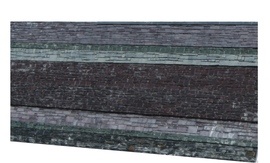 1 Slate: A fine-grained rock, typically bluish-gray in color, that can easily be split into thin layers and is commonly used as a roofing material
1 Slate: A fine-grained rock, typically bluish-gray in color, that can easily be split into thin layers and is commonly used as a roofing material
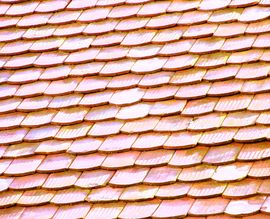 2 Shingles: A smooth, uniform, flat piece of construction material, available in a wide variety of materials and laid in a series of overlapping rows, used to cover the outside of roofs or walls to protect against weather damage and leaks.
2 Shingles: A smooth, uniform, flat piece of construction material, available in a wide variety of materials and laid in a series of overlapping rows, used to cover the outside of roofs or walls to protect against weather damage and leaks.
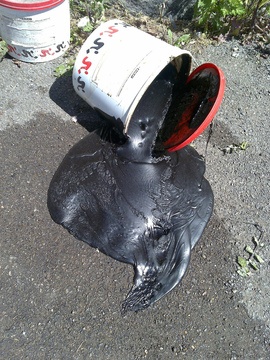 3 Asphalt: A viscous, black mixture of hydrocarbons often used for roofing and waterproofing. It is also used in asphalt for paving roads
3 Asphalt: A viscous, black mixture of hydrocarbons often used for roofing and waterproofing. It is also used in asphalt for paving roads
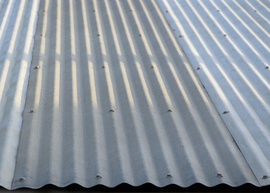 4 Fiber cement: A building material made with cellulose fiber, concrete, and recycled materials such as glass
4 Fiber cement: A building material made with cellulose fiber, concrete, and recycled materials such as glass
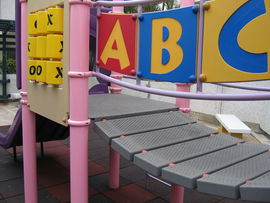 5 Rubber tiles: Soft interlocking tiles, usually made of rubber, used as a safe flooring for children's playground areas
5 Rubber tiles: Soft interlocking tiles, usually made of rubber, used as a safe flooring for children's playground areas
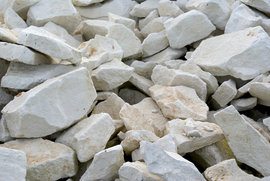 6 Limestone: A type of sedimentary rock, made up of mostly calcite and aragonite
6 Limestone: A type of sedimentary rock, made up of mostly calcite and aragonite
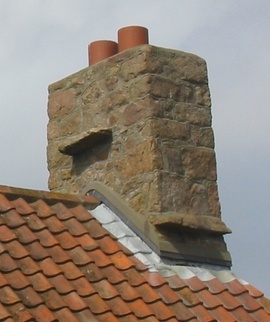 7 Flashing: Pieces of sheet metal used on roofs to cover joints, such as where the roof meets the wall, or around a chimney or skylight, to protect them and prevent water leaking through
7 Flashing: Pieces of sheet metal used on roofs to cover joints, such as where the roof meets the wall, or around a chimney or skylight, to protect them and prevent water leaking through
How much does it cost to install slate roof in my city?
Cost to install slate roof varies greatly by region (and even by zip code). To get free estimates from local contractors, please indicate yours.








